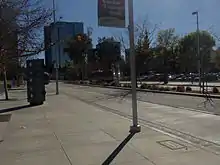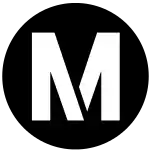Los Angeles County Metropolitan Transportation Authority
The Los Angeles County Metropolitan Transportation Authority (LACMTA), commonly branded as Metro is the agency that plans, operates, and coordinates funding for most of the transportation system in Los Angeles County. The agency directly operates a large transit system that includes bus, light rail, heavy rail (subway), and bus rapid transit services; and provides funding for transit it does not operate, including Metrolink commuter rail, municipal bus operators and paratransit services. Metro also provides funding and directs planning for railroad and highway projects within Los Angeles County.
 | |
 Four Metro-operated modes of service | |
| Overview | |
|---|---|
| Locale | Los Angeles County, California |
| Transit type |
|
| Number of lines |
|
| Number of stations | Rail: 93 Bus: 13,978[1] |
| Daily ridership | 1,174,751 (2019, weekdays)[2] |
| Chief executive | Phillip Washington[3] |
| Website | www |
| Operation | |
| Began operation | February 1, 1993[4] |
| Technical | |
| System length | Rail: 105 miles (169 km) Bus: 1,433 miles (2,306 km)[1] |
The LACMTA was formed in 1993 by a merger of the rival Southern California Rapid Transit District, a transit operator, and the Los Angeles County Transportation Commission, a transportation funding and planning agency. The agency is based out of the Metro Headquarters Building, a 26-story high-rise office tower located next to Union Station, a major transportation hub for Southern California.
Overview
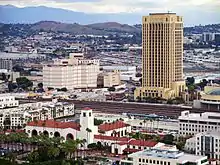
The agency develops and oversees transportation plans, policies, funding programs, and both short-term and long-range solutions to mobility, accessibility and environmental needs in the county. The agency is also the primary transit provider for the city of Los Angeles, providing the bulk of such services even though the city's Los Angeles Department of Transportation (LADOT) operates a smaller system of its own within the MTA service area in the city of Los Angeles: LADOT's Commuter Express bus service to outlying suburbs in the city of Los Angeles (with a few terminating in adjacent cities), the popular short distance DASH (Downtown Area Short Hop) mini-bus service in downtown and other neighborhoods exclusively in the city of Los Angeles. Metro's headquarters are in a high-rise building adjacent to Union Station in downtown Los Angeles.[5]
The Los Angeles County Metropolitan Transportation Authority operates the third-largest public transportation system in the United States by ridership with a 1,433 mi² (3,711 km²) operating area and 2,000 peak hour buses on the street any given business day.[6] Metro also operates 105 miles (169 km) of urban rail service.[1] The authority has 9,892 employees, making it one of the region's largest employers.[1]
The authority also partially funds sixteen municipal bus operators and an array of transportation projects including bikeways and pedestrian facilities, local roads and highway improvements, goods movement, Metrolink regional commuter rail, Freeway Service Patrol and freeway call boxes within the County of Los Angeles.
To increase sustainability in transportation services, Metro also provides bike and pedestrian improvements for the over 10.1 million residents of Los Angeles county.[7]
Security and law enforcement services on Metro property (including buses and trains) are currently provided by the Los Angeles County Sheriff's Department's Transit Services Bureau via contract, in conjunction with Metro Transit Enforcement Department, Los Angeles Police Department (Union Station and all LACMTA rail services within the City of Los Angeles) and in the city of Long Beach, the Long Beach Police Department.
Services
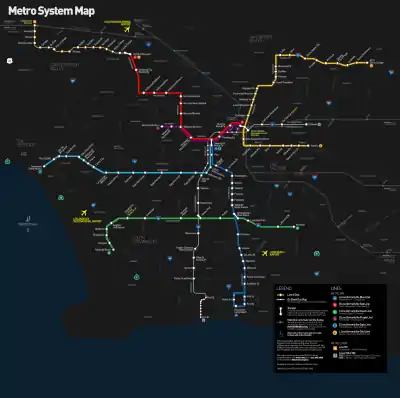
Metro Rail
Metro Rail is a rail mass transit system with two subway and four light rail lines. As of November 2016, the system runs a total of 105 miles (169 km), with 93 stations[1] and over 316,000 daily weekday boardings.
 A Line (opened 1990) is a light rail line running between Downtown Los Angeles and Downtown Long Beach.
A Line (opened 1990) is a light rail line running between Downtown Los Angeles and Downtown Long Beach.
 B Line (opened 1993) is a subway line running between Downtown Los Angeles and North Hollywood.
B Line (opened 1993) is a subway line running between Downtown Los Angeles and North Hollywood.
 C Line (opened 1995) is a light rail line running between Redondo Beach and Norwalk, largely in the median of the 105 Freeway. It provides indirect access to Los Angeles International Airport via a shuttle bus.
C Line (opened 1995) is a light rail line running between Redondo Beach and Norwalk, largely in the median of the 105 Freeway. It provides indirect access to Los Angeles International Airport via a shuttle bus.
 D Line (opened 2006) is a subway line running between Downtown Los Angeles and the Mid-Wilshire district of Los Angeles. Most of its route is shared with the B Line.
D Line (opened 2006) is a subway line running between Downtown Los Angeles and the Mid-Wilshire district of Los Angeles. Most of its route is shared with the B Line.
 E Line (opened 2012) is a light rail line running between Downtown Los Angeles and Santa Monica.[8]
E Line (opened 2012) is a light rail line running between Downtown Los Angeles and Santa Monica.[8]
 L Line (opened 2003) is a light rail line running between East Los Angeles and Azusa via Downtown Los Angeles.[9]
L Line (opened 2003) is a light rail line running between East Los Angeles and Azusa via Downtown Los Angeles.[9]
Metro Bus
Metro is the primary bus operator in the Los Angeles Basin, the San Fernando Valley, and the western San Gabriel Valley. Other transit providers operate more frequent service in the rest of the county. Regions in Los Angeles County that Metro Bus does not serve at all include rural regions, the Pomona Valley, the Santa Clarita Valley, and the Antelope Valley.
Metro operates two types of bus services which are distinguished by the color of the buses.[10] However, when mechanical problems or availability equipment occurs, a bus of any color may be substituted to continue service on the route.
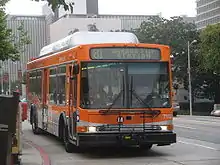
Metro Local buses are painted in an off-orange color which the agency has dubbed “California Poppy”. This type of service makes frequent stops along major thoroughfares. There are 18,500 stops on 189 bus lines. Some Metro Local routes make limited stops along part of their trip but do not participate in the Rapid program. Some Metro Local bus lines are operated by contractors MV Transportation, Southland Transit, and Transdev (formerly Veolia).

Metro Rapid buses are distinguished by their bright red color which the agency has dubbed “Rapid Red”. This bus rapid transit service offers limited stops on many of the county's more heavily traveled arterial streets. Metro claims to reduce passenger commute times by up to 25% by several methods, among them a headway-based schedule so that drivers are not held up at certain stops and signal priority for Rapid buses.[11]
Metro Express buses are minimal stop services along Los Angeles's extensive freeway network. There are 7 lines running and 1 line suspended as of Early 2020: 456, 460, 487, 489, 501, 534, 550, and 577.
Metro Busway

Metro Busway is a bus rapid transit system with two lines operating on dedicated or shared-use busways. The system runs a total of 60 miles (97 km), with 28 stations and over 42,000 daily weekday boardings as of May 2016.
The Metro Busway system is meant to mimic the Metro Rail system, both in the vehicle's design and in the operation of the line. Vehicles stop at dedicated stations (except for the portion of the Metro J Line in Downtown Los Angeles), vehicles receive priority at intersections and are painted in a silver livery similar to Metro Rail vehicles.
 G Line (opened 2005) is a bus rapid transit line running between North Hollywood and Chatsworth.
G Line (opened 2005) is a bus rapid transit line running between North Hollywood and Chatsworth.
 J Line (opened 2009) is a bus rapid transit line running between El Monte, Downtown Los Angeles, and Harbor Gateway, with some buses also serving San Pedro.
J Line (opened 2009) is a bus rapid transit line running between El Monte, Downtown Los Angeles, and Harbor Gateway, with some buses also serving San Pedro.
Busways
The Metro Busway J Line operates over two busways, semi-exclusive roadways built into the Southern California freeway system. These busways are also used by other bus routes to speed up their trips.
- El Monte Busway (opened in 1974) is a combination busway and high-occupancy toll (HOT) roadway that runs in the median of the San Bernardino Freeway (I-10 ) and on a separate right-of-way. The busway provides express bus service between Downtown Los Angeles and the San Gabriel Valley . Services on the busway are operated by both Metro and Foothill Transit .
- Harbor Transitway (opened in 1998) is a combination busway and HOT roadway that runs in the median of the Harbor Freeway (I-110 ). The busway provides express bus service between San Pedro and Downtown Los Angeles. Services on the busway are operated by Metro, Orange County Transportation Authority , LADOT , Gardena Municipal Bus Lines and Torrance Transit .
Other services
- Metro ExpressLanes: High-occupancy toll lanes (HOT)
- Metro Freeway Service Patrol: A joint effort between Metro, Caltrans, and CHP offering free quick-fix repairs and towing from freeways.
- HOV (Carpool) Lanes: 219 miles (352 km), 423 miles (681 km) both directions/each lane, of carpool, vanpool, and express bus lanes.
- Bike paths: 475 miles (764 km) of bikeways for commuter and recreational purposes.
- Metrolink: Partially funded by Metro, it is Southern California's regional commuter rail system serving the Greater Los Angeles metropolitan area (L.A., O.C., Riverside, San Bernardino, and Ventura counties), as well as Oceanside in northern San Diego County.
- Metro Bike Share: A bikeshare program called which operates within Downtown Los Angeles, Venice, and the Port of Los Angeles. The system was introduced in early 2016 at a cost $16 million and uses about 1,400 bikes and 93 stations.[12]
Fares
All Metro passes are sold on TAP Cards, smart fare cards on which customers can load value or a pass; they are valid on all Metro buses and trains as well as most city buses.
Faregates at some Metro Rail stations and the G Line require a TAP card, but Metro as a whole operates on a proof-of-payment system. The Los Angeles County Sheriff's Department, Los Angeles Police Department, Long Beach Police Department and Metro's fare inspectors conduct random ticket inspections throughout the system. If customers are caught without a valid TAP card, they may be fined and/or subject to community service.
Fare evasion was estimated in 2007 to be at 6%, costing Metro $2.6 million annually. In response to this, the Metro board approved fare gating of all stations on the Red and Green Lines, and selected stations on the Orange, Blue, and Gold Lines, capturing 84% of passengers using the system. Adding fare gates was selected to increase fare collections, implement distance based fares on rail and transitways in the future, and reduce the potential of the system to terrorist attack.[13] Former Metrolink executive director Richard Stanger critiqued the gate installation by citing its cost and ineffectiveness, concerns ultimately dismissed by the Metro board.[14]
Ridership
The Metro B Line has the highest ridership of all the Metro Rail Lines. The Metro B Line's operational cost is the lowest of all of the Metro Rail lines because of its high ridership. The Metro Liner Metro J Line has the lowest ridership of all color-branded lines. Average daily boardings and passenger miles for all of 2018 are as follows:[2]
| Service | Weekdays | Saturdays | Sundays and Holidays | Average Weekday Passenger Miles |
|---|---|---|---|---|
| Heavy Rail | ||||
| 137,142 | 81,837 | 70,250 | 648,132 | |
| Light Rail | ||||
| 64,648 | 32,075 | 29,013 | 482,659 | |
| 30,839 | 16,504 | 13,588 | 219,700 | |
| 61,024 | 37,321 | 32,966 | 424,643 | |
| 50,523 | 31,280 | 24,937 | 441,140 | |
| Bus and BRT | ||||
| Metro Bus | 878,862 | 550,391 | 423,771 | 3,739,826 |
| 22,573 | 12,698 | 10,212 | 148,944 | |
| 15,059 | 6,346 | 5,127 | 152,706 | |
| Total Bus and Rail | 1,214,893 | 752,462 | 601,200 | 5,824,359 |
Governance
Metro is governed by a Board of Directors with 14 members, 13 of whom are voting members.[15] The Board is composed of:
- The five Los Angeles County Supervisors (Solis, Ridley-Thomas, Kuehl, Hahn, Barger)
- The mayor of Los Angeles (Garcetti) (currently chair)
- Three Los Angeles mayor-appointees (at least one of whom must be an L.A. City Council member)
- Four city council members or mayors from cities other than Los Angeles, but within L.A. county representing those 87 cities (selected by the L.A. County City Selection Committee): currently, the representatives are from Duarte, Glendale, Long Beach, and Santa Monica
- One non-voting member appointed by the Governor of California (traditionally the Director of Caltrans District 7)
In addition, Service Councils, composed of political appointees from various regions of Los Angeles County, approve service changes and oversee bus routes within a region. There are five regions: Gateway Cities, San Fernando Valley, San Gabriel Valley, South Bay, and Westside/Central. Service councils advise on planning and implementation of service within their area; call and conduct public hearings and evaluate Metro bus programs to their area; make policy recommendations to the Metro Board; and participate in quarterly meetings with the Metro Chief Executive Officer (CEO), Deputy CEO and management staff.
Service councils were created as governance councils in 2001, in response to complaints about the effectiveness of Metro service in suburban areas. Communications between sectors and riders was poor, according to a report by the California State Auditor which was released one year into the new structure.[16] In addition, each sector had its own scheduling, operations, and maintenance divisions, causing effort duplication, organizational silos, and inefficiency.[17] Thus, in 2009, the sectors were eliminated, and transportation, maintenance, service planning, and administration were recentralized under the guidance of Metro's Chief Operations Officer. Governance councils, renamed service councils, now have more responsibility over local issues such as stop placement and service changes, while larger issues are handled by the Metro board.[18]
In some cases, governance of Metro lies in the hands of local governmental bodies, such as school boards, and local elected officials. The Beverly Hills Unified School District board, along with its president Lisa Korbatov, is one such example. In 2018, Korbatov was serving her second term as president of the board. She led a public campaign opposed to the extension of the Purple Line subway underneath Beverly Hills High School. Additionally, she rounded up enough signatures to send a petition to President Donald Trump, asking him to withhold federal funding and force the Los Angeles County Metropolitan Transportation Authority to re-route the subway tunnel away from the high school.[19]
Funding
A complex mix of federal, state, county and city tax dollars as well as bonds and fare box revenue funds Metro. The Metro budget for 2020 is $7.2 billion. Below is the funding breakdown from Metro's fiscal year 2020 budget.
| Revenues | US$ in Millions 2020[20] |
|---|---|
| Proposition A (0.5% sales tax) | 873 |
| Proposition C (0.5% sales tax) | 873 |
| Measure R (0.5% sales tax) | 873 |
| Measure M (0.5% sales tax) | 873 |
| Transportation Development Act (0.25% sales tax) | 436.5 |
| State Transit Assistance ("Diesel Tax") | 215.8 |
| SB 1 State of Good Repair Funding ("Gas Tax") | 30.1 |
| Metro Passenger Fares | 284.5 |
| Metro ExpressLanes Tolls | 58.4 |
| Advertising | 25.6 |
| Other Revenues | 71.2 |
| Grants Reimbursements | 1,184.8 |
| Bond Proceeds & Prior Year Carryover | 1,408.6 |
| Total Resources (US$ millions) | 7,207.6 |
Fleet

All Metro buses are CNG-powered, the largest such fleet in the United States.[21] The CNG fleet reduces emissions of particulates by 90%, carbon monoxide by 80%, and greenhouse gases by 20% compared to diesel powered buses. Alternative fuel buses have logged more than 450 million operating miles since 1993, an industry record.
As part of Metro's ATMS project, most buses include a marquee displaying the date and time, Automatic Voice Annunciation (AVA) for audio and visual announcements for each stop, and an audio and visual Stop Requested announcement.
MV Transportation, Southland Transit, and Transdev are bus contractors; these contractors currently operate a few NABI 40-LFW (7600-7949) series, all NABI 31-LFW (3100-3149) series, and some NFI XN40 (5600-6149) & (3850-4199) series.
Metro Local buses are painted orange ("California Poppy"), Metro Rapid buses are painted red, and Metro J Line buses are painted silver. Metro Local buses acquired prior to the adoption of these colors in 2004 are white with a gold stripe around the bus; these buses been painted orange during their mid-life rehabilitation (except for the 5300-series New Flyer buses assigned to Metro Rapid lines, which were repainted in red livery in 2004-05). The 7000- and 7600-series buses acquired for Metro Rapid service in 2000 and 2002 are red with a white stripe along the top (7102-7112, 7617-7618, 7628, 7643, 7646 were white with a red Metro Rapid logo on all sides and some of these buses have been repainted to standard red and white and a few have been converted to Metro Local service), but some have been repainted to the current red and silver livery. Most had been repainted beginning in 2007; some have been repainted either in the updated Metro Rapid scheme or in Metro Local colors.
Metro operates the nation's largest fleet of CNG-powered buses. The CNG fleet reduces emissions of particulates by 90%, carbon monoxide by 80%, and greenhouse gases by 20% over the 500 remaining diesel powered buses in the fleet. Alternative fuel buses have logged more than 450 million operating miles since 1993, an industry record. Metro has retired all diesel buses (not including contracted buses) and became an entirely clean-air fleet in January 2011.
Beginning December 17, 2006, Metro Local Lines 233 (Van Nuys Blvd.) and 204 (Vermont Ave.) were the first Metro Local lines to use 60-foot (18 m) NABI articulated buses (9400-9494 and some 9500-9594 series). These buses are also currently in use on Metro Local Line 40 (Hawthorne Bl./Crenshaw Bl./MLK Bl./Broadway Ave.), Metro Local Line 66 (8th Street/E. Olympic Bl.) and Metro Local Line 207 (Western Ave.).
History
LACMTA was formed in 1993 from the merger of two previous agencies: the Southern California Rapid Transit District (SCRTD or more often, RTD) and the Los Angeles County Transportation Commission (LACTC). RTD was during the 1960s to 1980s (until the LACTC was created) the "800 pound gorilla" in bus transportation in Southern California, operating most public transportation in Los Angeles, Orange, San Bernardino, and Riverside Counties, although outlying services began to be divested in the early 1980s.
Future

Metro has expanded its Metro Rapid bus system with a goal of 28 lines since 2008.[22] A Special Master ruling in December 2005 requires Metro to increase service on all Rapid bus routes to every 10 minutes during the peak period and every 20 minutes during the mid-day and evening. Service would be required to operate between 5 a.m. and 9 a.m. on all Rapid routes. Metro has chosen not to appeal the ruling and began implementation on all Rapid routes in June 2006.
In addition, the agency is embarking on a massive bus restructuring effort entitled Metro Connections. The project is designed to convert the current grid-based bus system, implemented in 1980, to a hub and spoke system focused on activity centers.[23] The system is to be phased in the next four years, and will include new express routes and reconfigured local service. Suburban service and low ridership shuttles will be considered for operation by municipal agencies, restructuring, or cancellation.
The Universal Fare system called 'TAP' which stands for Transit Access Pass was introduced to the public in early 2010. The TAP smart card uses near-field communication allowing bus and rail passengers to physically tap their cards on the farebox or fare-gate for faster boarding.
In 2015, Metro studied renaming its rail and bus rapid transit lines using a letter-based scheme.[24]
Crenshaw/LAX Line
The Crenshaw/LAX Line is being built from Aviation/LAX station on the C Line to Expo/Crenshaw station on the E Line, passing through Inglewood and Crenshaw, Los Angeles. It will connect with a people mover to serve Los Angeles International Airport. A further phase will extend the line to Hollywood to connect with the B Line.
Gold Line Foothill Extension
Metro is planning an extension of the Gold Line into the San Gabriel Valley to the San Bernardino County border city of Montclair. The first phase of this extension, to Azusa, opened on March 5, 2016. Construction for Phase 2 began on December 2, 2017 and is expected to complete by early 2026.
Regional Connector
The Regional Connector is a tunnel under Downtown Los Angeles, joining the L Line at Little Tokyo Station (1st Street and Central Avenue) to the A Line (Blue Line) and E Line (Expo Line) at 7th Street/Metro Center. This will lead to the creation of two lines, one between Long Beach and Azusa, and the other between East Los Angeles and Santa Monica.
Purple Line Extension
Phase 1 of the Purple Line Extension will add three new subway stations to the D Line (Purple Line) at Wilshire/La Brea, Wilshire/Fairfax, and Wilshire/La Cienega. Further phases will extend the D line to Century City and Westwood. Construction of the second section began in 2018.[25]
West Santa Ana Transit Corridor
The West Santa Ana Transit Corridor has been designated as a priority for mass transit development, making use of the mostly disused Pacific Electric West Santa Ana Branch via Stanton and Garden Grove to Santa Ana for future expansion of rail or busway service. The current proposal is a light rail line with a new route from Union Station to the C Line, then the West Santa Ana Branch right-of-way to Artesia.[26][27]
The Orange County Transportation Authority (OCTA) is collaborating with the cities of Santa Ana and Garden Grove on the OC Streetcar on the southerly portion of the West Santa Ana Branch.[28]
Clean air
Metro aims to have a fully electric bus system by 2030, along with a full switch to electric operations for the G and J lines by 2020 and shortly after, respectively. [29]
Measure M
Measure M, passed on November 2016, extends and increases the Measure R 30-year half-cent sales tax to a permanent one-cent sales tax. This tax is expected to fund $120 billion in highway and transit projects over 40 years.[30] The tax is also expected to support over 778,000 jobs in the Los Angeles area and $79.3 billion in economic output.[31]
Projects to be funded by Measure M include:[30][32]
- Construction of the Aviation/96th Street station to connect the Crenshaw/LAX Line to LAX terminals via the Airport Metro Connector
- Extension of the Crenshaw/LAX Line to Hollywood, connecting to the B Line at Hollywood/Highland station
- A streetcar in Downtown Los Angeles
- The third segment of the D Line extension, from Century City to Westwood/VA Hospital
- The Los Angeles County portion of the High Desert Corridor: a freeway, rail transit, and bikeway corridor linking cities in the Antelope and Victor Valleys. Caltrans put the freeway on hold in 2019.[33]
- Bus Rapid Transit connecting the G and B Lines in North Hollywood with the L Line in Pasadena
- Conversion of the G Line from Bus Rapid Transit to Light Rail
- Light Rail along Van Nuys Boulevard to San Fernando
- Light Rail along the West Santa Ana Branch from Union Station to Artesia
- Bus Rapid Transit along Vermont Avenue between the B Line at Hollywood Blvd. and the C Line at 120th St.
- Southern extension of the C Line to Torrance Transit Center
- Eastern extension of the C Line to the Norwalk/Santa Fe Springs Metrolink station
- Heavy Rail tunnel underneath or monorail over the Sepulveda Pass linking the G Line in the San Fernando Valley and the D Line at Westwood/UCLA
- Heavy Rail or Monorail extension from the D line at Westwood/UCLA to LAX
- Extension of the L Line from East Los Angeles with a branch to Whittier next to the San Gabriel River
- Bus Rapid Transit from LAX to the E Line at Santa Monica along Lincoln Blvd.
- Bus Rapid Transit in the North San Fernando Valley
General
Metro has a project list including all current projects being pursued in Los Angeles County, as well as an interactive map.
Photo gallery
 Interior of Metro Local Bus – NABI 40 LFW.
Interior of Metro Local Bus – NABI 40 LFW. Metro Local Line 166 using a NABI 45C bus.
Metro Local Line 166 using a NABI 45C bus. Line 166 at the Chatsworth Orange Line Station.
Line 166 at the Chatsworth Orange Line Station. Metro Local Line 166 departing.
Metro Local Line 166 departing. Interior of a Metro Gold Line train car – Breda P2550 train.
Interior of a Metro Gold Line train car – Breda P2550 train. Metro Silver Line bus departing Manchester Silver Line station.
Metro Silver Line bus departing Manchester Silver Line station. Metro Local Line 232, a contract (pre-2015) bus line using a now retired Orion Bus
Metro Local Line 232, a contract (pre-2015) bus line using a now retired Orion Bus Inside a NABI 45 compobus on Los Angeles Metro Local line: 81.
Inside a NABI 45 compobus on Los Angeles Metro Local line: 81.
In popular culture
The Metro rail and bus fleet often make appearances in films and television shows produced in the Los Angeles area, including 2012, Crash,[34] Lethal Weapon 3, Volcano,[35] Superbad, Collateral,[35] The 40-Year-Old Virgin,[36] Battle: Los Angeles,[37] and Captain Marvel.[35] One of the earliest appearances was in the 1994 movie Speed with Keanu Reeves and Sandra Bullock, in which the Metro plays a key part in the plot.[35]
See also
- Transportation in Los Angeles
- List of Los Angeles County Metro Rail stations
- List of Los Angeles County Metro Liner BRT Stations
- List of former Metro Express routes
- People
- Hal Bernson, former Authority chairman
References
- "Facts At A Glance". Metro. Retrieved 16 February 2016.
- "Ridership Statistics". www.metro.net. Retrieved 2020-08-17.
- "Phillip Washington, Denver transit chief, to become Metro's new CEO". KPCC. March 12, 2015. Retrieved 19 April 2015.
- [California Public Utilities Code, Section 130051.10] Retrieved 1/26/2018
- "Help & Contacts." Los Angeles County Metropolitan Transportation Authority. Retrieved on March 18, 2010.
- APTA Ridership Reports Statistics – United States Transit Agency Totals Index Archived 2006-03-14 at the Wayback Machine. Retrieved April 4, 2006
- "Metro Sustainability".
- Nelson, Laura J. (February 25, 2016). "Metro Expo Line to begin service to Santa Monica on May 20". Los Angeles Times.
- Scauzillo, Steve (February 26, 2016). "When is the grand opening of the Gold Line Foothill Extension?". San Gabriel Valley Tribune.
- "Bold New Look Proposed For Metro Buses, Trains, 'M' Logo". Los Angeles County Metro. 19 June 2003. Retrieved 2008-03-10.
- "Final Report Los Angeles Metro Rapid Demonstration Program" (PDF).
- "Metro Bike Share: About". 2015-01-27. Retrieved October 21, 2018.
- "Metro Rail Gating Study" (PDF). November 15, 2007.
- https://www.metro.net/board/Items/2008/02_February/20080228RBMItem36.pdf
- "California Code, Public Utilities Code – PUC § 130051". Findlaw. Retrieved 2019-03-02.
- "Los Angeles County Metropolitan Transportation Authority: It Is Too Early to Predict Service Sector Success, but Opportunities for Improved Analysis and Communication Exist." page 41, California State Auditor, December 2003. Retrieved May 1, 2006.
- https://www.metro.net/board/Items/2009/11_November/20091118OPItem48.pdf
- "Metro in Transition". Streetsblog Los Angeles. 2009-12-02. Retrieved September 13, 2016.
- "Force behind campaign against Metro's Purple Line may have a Trump card". The Real Deal Los Angeles. 2018-07-09. Retrieved 2019-05-27.
- "FY20 Adopted Budget" (PDF). Los Angeles County Metropolitan Transportation Authority. July 1, 2019. Retrieved February 10, 2020.
- "Metro Gets Grant For Purchase of More Clean-Air Buses". Los Angeles County Metro. 26 April 2006. Retrieved 2007-01-07.
- Overview of Transportation Topics. Realtor.org. Retrieved April 4, 2006.
- "Metro Connections Update" (PDF). January 2006.
- Loos, Chris (April 2, 2015). "Metro Proposes Simplified Naming Convention for Rail Lines". Urbanize.LA. Retrieved 3 April 2015.
- "The long-awaited Metro Purple Line Subway Extension is now under construction".
- Sharp, Steven (September 15, 2015). "Metro Exploring New Options for West Santa Ana Branch". Urbanize.LA. Retrieved June 7, 2016.
- Nelson, Laura J. (May 23, 2018). "Metro narrows the options for a light-rail line from downtown L.A. to Artesia". Los Angeles Times. Retrieved 26 May 2018.
- Escobar, Allyson (2017-06-11). "Orange County's first modern streetcar plans to be the future of transit on track". Los Angeles Times. Retrieved 2017-08-06.
- "Fresh Air".
- "Measure M: Metro's Plan to Transform Transportation in LA". The Plan. Retrieved 2016-11-11.
- "Fresh Air".
- "Measure M project descriptions". The Source. 2016-11-09. Retrieved 2016-11-11.
- "Editorial: It was a terrible idea to build a new freeway in Los Angeles County. Now it's on hold for good". Los Angeles Times. 2019-10-06. Retrieved 2019-10-17.
- "New Flyer C 40 LF in "Crash"".
- Roe, Mike; Fonseca, Ryan (March 7, 2019). "Captain Marvel Takes LA Metro, But She's Not The First Movie Hero To Go For A Ride". LAist. Archived from the original on March 8, 2019.
- "Neoplan AN 440 Transliner in "The 40 Year Old Virgin"".
- "NABI 416 in "Battle: Los Angeles"".
External links
| Wikimedia Commons has media related to Los Angeles County Metropolitan Transportation Authority. |
